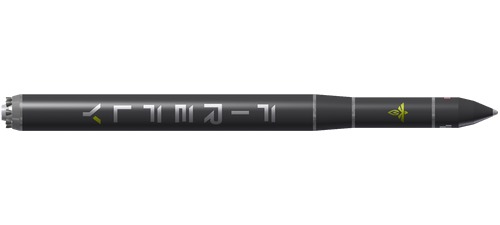
Illustration of the Firefly Alpha small launch vehicle, designed to place up to 400 kilograms into orbit. (credit: Firefly Space Systems)
Last week, startup launch vehicle developer Firefly Space Systems formally announced its first rocket: Firefly Alpha. The two-stage vehicle uses liquid oxygen and methane propellants in pressure-fed configurations. While the second stage uses a conventional bell-shaped nozzle, the first stage features a “plug cluster aerospike” design, using aerodynamics rather than a nozzle to direct the exhaust. The vehicle will be able to place up to 400 kilograms into low Earth orbit.
“We are offering small satellite customers the launch they need for a fraction of that, around $8 or 9 million – the lowest cost in the world,” claimed Firefly CEO Thomas Markusic in a company press release. “It’s far cheaper than the alternatives, without the headaches of a multi manifest launch.”
Firefly (sometimes spelled “FireFly” on the company’s website) has been operating relatively quietly for some time. Investor Michael Blum, who co-founded the company with Markusic and P.J. King, announced Firefly in a blog post at Hedgeye, the financial media company he runs, back in January. In that post, he said the company had set a goal of the first orbital launch in three years. Last week’s press release did not disclose a timeline for the first Firefly Alpha launch.
Firefly has offices in Austin, Texas, and in Hawthorne, California, the latter right next door to SpaceX (where Markusic once worked.) Blum, in his January post, said Austin is the company’s headquarters and Hawthorne is an R&D center. The company doesn’t distinguish those locations that way on its website, but all of the company’s current job openings, including a number of engineering and technician positions, are in Austin.
The company’s argument is that it is uniquely positioned to serve the growing small satellite market. “Until now, there existed virtually no dedicated launcher capacity in the small satellite industry to deliver their respective payloads to orbit,” Blum said in last week’s press release. “This announcement today just changed all that.”
It is probably more accurate to say that there are no affordable dedicated smallsat launch options today, which also depends on the meaning of “affordable.” For example, Orbital Sciences Corporation’s Pegasus XL can launch payloads weighing as much as 450 kilograms, depending on the orbital altitude and inclination, but with estimated costs of $30 million or more per launch, it’s not affordable by most non-government customers—and even some government customers.
It’s worth recalling the lesson of SpaceX’s first rocket, the Falcon 1. It had a similar payload performance: about 450 kilograms, at an original cost of about $6–7 million. (The larger, but never flown, Falcon 1e would have had a larger payload, of about 1,000 kilograms, but also a higher price, about $11 million.) However, SpaceX struggled to win business for the Falcon 1 at those prices, even after the vehicle got past its initial development struggles, and SpaceX elected to retire the vehicle so it could focus on the larger—and more lucrative—Falcon 9 and Falcon Heavy.
And, by the time Firefly Alpha is ready in two to three years (assuming they stay on Blum’s original timeline), the company will be facing competition at the small end of the market. Air launch systems like Boeing’s ALASA (being developed under contract with DARPA), Generation Orbit’s GOLauncher 2, and Virgin Galactic’s LauncherOne will be, or soon be, in service and seeking smallsat payloads. While some of these systems are smaller than Firefly Alpha—ALASA and GOLauncher 2 will have capacities of about 45 kilograms—they’ll also be far less expensive and perhaps better sized to perhaps the fastest-growing part of the market, nanosatellites weighing a few tens of kilograms. A number of other companies are examining the very low end of the smallsat market.
Thus, all the technical merits of Firefly’s launch vehicle may be moot if their vehicle isn’t sized and priced the effectively meet the needs of the market.

Obviously Alpha is a stepping stone for Beta.
It is extremely hard to make a 2 stage pressure fed vehicle close on an orbital solution.
Microcosm played hard at this problem along with Bob Truax and a number of other very competent engineers.
I hope they get some gains on a aerospike, but, the problem is less then tractable.
They may find that they need 3 stages to make the solution close.